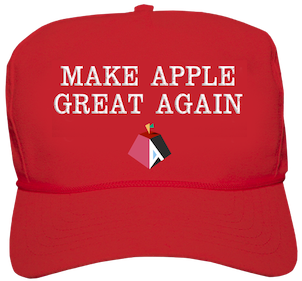Linux is making Apple Great Again

MAGA pun aside, Linux is doing more for Apple hardware than macOS right now… at least in the eyes of some old UNIX nerds like me.
At the Southern California Linux Expo (SCaLE) earlier this month, the closing keynote was given by Ken Thompson (co-creator of the UNIX operating system and the Go programming language). During the Q&A session following that keynote, Ken was asked “What’s your operating system of choice, today?” While you can watch it here, his response was:
“I have for most of my life, because I was sort of born into it, run Apple. Right now, recently, meaning within the last five years, I’ve become more and more and more depressed and [Laughter] what Apple is doing to something which should allow you to work is just atrocious, but they are taking a lot of space and time to do it so it’s ok. [Laughter] And I have come within the last month or two to say even though I’ve invested a zillion years in Apple, I’m throwing it away and I’m going to Linux. To Raspbian in particular. [Applause] Anyway, I’m half transitioned now.”
As an Apple user since the early days of Mac OS X UNIX (now called macOS), I mirror Ken’s sentiment exactly. Many of us watching Apple these past two decades have seen macOS move slowly towards closed standards and tighter control, instead of openness and functionality. When I boot my mid-2000s era Apple PowerBook G4 for a nostalgia kick, I’m reminded of how great macOS once was.
Of course, openness and functionality do not generate as much profit for companies compared to the alternative, and Apple is essentially just a soulless corporation. But as Ken pointed out, they’ve been doing it over a long period of time, so it’s OK (i.e., it’s given us plenty of time to move to alternatives).
While macOS stirs no excitement today compared to Linux (or even Windows), Apple’s hardware has always been excellent (with the exception of the time period between 2015 and 2019). And when Apple introduced the high performance and low power ARM-based Apple Silicon architecture in 2020, hardware became their main selling point to tech professionals. The only downside was having to use macOS to take advantage of it. And for many - including Ken Thompson - this was a deal breaker.
The creator of the Linux operating system, Linus Torvalds, holds the same opinion. When asked on a Real World Technologies forum whether he would buy an Apple Silicon laptop, he responded with:
“I’d absolutely love to have one, if it just ran Linux. I have fairly fond memories of the 11” Macbook Air (I think 4,1) that I used about a decade ago (but moved away from because it took Apple too long to fix the screen - and by the time they did, I’d moved on to better laptops, and Apple had moved on to make Linux less convenient). Apple may run Linux in their cloud, but their laptops don’t. I’ve been waiting for an ARM laptop that can run Linux for a long time. The new Air would be almost perfect, except for the OS. And I don’t have the time to tinker with it, or the inclination to fight companies that don’t want to help."
Just like Linus, I’ve wanted an ARM-based workstation for years and was glad to hear that Apple finally brought one to market with stellar performance. But like Ken and Linus, I didn’t want to run macOS on it. I wanted to run Linux. And after reading hundreds of Internet comments on articles, forums, and blog posts, it was clear that many others felt the same way.
Luckily, booting non-macOS operating systems on Apple Silicon is formally allowed by Apple. Apple won’t help you figure out how to do it, nor give you the information necessary to create device drivers for their hardware, but the possibility is there.
And possibility is all the open source community needs. The month after Apple started shipping computers with Apple Silicon, Hector Martin announced the Asahi Linux project whose goal was to reverse engineer the Apple Silicon hardware platform to run an ARM64 Linux distribution natively. Because so many people wanted this to happen, Hector was able to work full time on the project since early 2021 with financial support from the community via Patreon. Progress was made rapidly, and many other open source contributors joined the project. A fully functional (and in my opinion, quite polished) alpha release of Asahi Linux (based on Arch Linux ARM) was made available in March 2022, with development of remaining features accelerating throughout the year. The GPU driver was completed in December 2022 and updated to be faster than Apple’s own GPU driver for macOS in March 2023.
Asahi Linux exemplifies the benefits of open source: fast, collaborative development to solve a popular need. It’s also a stellar example of how to run an open source project well by focusing on community, tooling, and users. To learn more, you can watch Hector’s talk on the project or read the Asahi blog.
I’ve been using Asahi Linux as my main workstation since March 2022, and now run it on a Mac Studio as I describe in my previous blog post. Essentially, I’m running the world’s most powerful and extensible operating system (Linux) on excellent hardware (Apple Silicon). In many ways, I believe the Asahi Linux project has made Apple great again for tech enthusiasts and professionals alike. It feels like the mid-2000s again, and I think that’s a good thing.